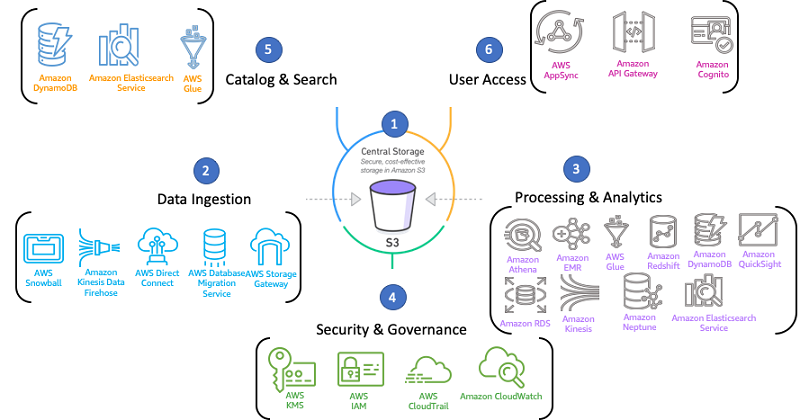AWS Big Data Blog
Build an AWS Well-Architected environment with the Analytics Lens
Building a modern data platform on AWS enables you to collect data of all types, store it in a central, secure repository, and analyze it with purpose-built tools. Yet you may be unsure of how to get started and the impact of certain design decisions. To address the need to provide advice tailored to specific technology and application domains, AWS added the concept of well-architected lenses 2017. AWS now is happy to announce the Analytics Lens for the AWS Well-Architected Framework. This post provides an introduction of its purpose, topics covered, common scenarios, and services included.
The new Analytics Lens offers comprehensive guidance to make sure that your analytics applications are designed in accordance with AWS best practices. The goal is to give you a consistent way to design and evaluate cloud architectures, based on the following five pillars:
- Operational excellence
- Security
- Reliability
- Performance efficiency
- Cost optimization
The tool can help you assess the analytics workloads you have deployed in AWS by identifying potential risks and offering suggestions for improvements.
Using the Analytics Lens to address common requirements
The Analytics Lens models both the data architecture at the core of the analytics applications and the application behavior itself. These models are organized into the following six areas, which encompass the vast majority of analytics workloads deployed on AWS:
- Data ingestion
- Security and governance
- Catalog and search
- Central storage
- Processing and analytics
- User access
The following diagram illustrates these areas and their related AWS services.

There are a number of common scenarios where the Analytics Lens applies, such as the following:
- Building a data lake as the foundation for your data and analytics initiatives
- Efficient batch data processing at scale
- Building a platform for streaming ingest and real-time event processing
- Handling big data processing and streaming
- Data-preparation operations
Whichever of these scenarios fits your needs, building to the principles of the Analytics Lens in the AWS Well-Architected Framework can help you implement best practices for success.
The Analytics Lens explains when and how to use the core services in the AWS analytics portfolio. These include Amazon Kinesis, Amazon Redshift, Amazon EMR, Amazon Athena, AWS Glue, Amazon OpenSearch and AWS Lake Formation. It also explains how Amazon Simple Storage Service (Amazon S3) can serve as the storage for your data lake and how to integrate with relevant AWS security services. With reference architectures, best practices advice, and answers to common questions, the Analytics Lens can help you make the right design decisions.
Conclusion
Applying the lens to your existing architectures can validate the stability and efficiency of your design (or provide recommendations to address the gaps that are identified). AWS is committed to the Analytics Lens as a living tool; as the analytics landscape evolves and new AWS services come on line, we’ll update the Analytics Lens appropriately. Our mission will always be to help you design and deploy well-architected applications.
For more information about building your own Well-Architected environment using the Analytics Lens, see the Analytics Lens whitepaper.
Special thanks to the following individuals who contributed to building this resource, among many others who helped with review and implementation: Radhika Ravirala, Laith Al-Saadoon, Wallace Printz, Ujjwal Ratan, and Neil Mukerje.
Are there questions you’d like to see answered in the tool? Share your thoughts and questions in the comments.
About the Authors
 Nikki Rouda is the principal product marketing manager for data lakes and big data at Amazon Web Services. Nikki has spent 20+ years helping enterprises in 40+ countries develop and implement solutions to their analytics and IT infrastructure challenges. Nikki holds an MBA from the University of Cambridge and an ScB in geophysics and math from Brown University.
Nikki Rouda is the principal product marketing manager for data lakes and big data at Amazon Web Services. Nikki has spent 20+ years helping enterprises in 40+ countries develop and implement solutions to their analytics and IT infrastructure challenges. Nikki holds an MBA from the University of Cambridge and an ScB in geophysics and math from Brown University.
 Radhika Ravirala is a specialist solutions architect at Amazon Web Services, where she helps customers craft distributed analytics applications on the AWS platform. Prior to her cloud journey, she worked as a software engineer and designer for technology companies in Silicon Valley.
Radhika Ravirala is a specialist solutions architect at Amazon Web Services, where she helps customers craft distributed analytics applications on the AWS platform. Prior to her cloud journey, she worked as a software engineer and designer for technology companies in Silicon Valley.